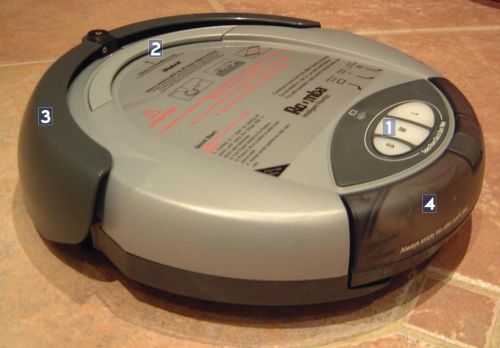
Submission by Peter White – WHAT IS ROOMBA? Roomba is an ‘intelligent floorvac’ designed, as the manufactures put it, to “…keep your floors clean in-between periodic deep cleanings”.
Roomba ships with a NiMH rechargeable battery (good for up to 90 minute cleaning, depending on floor type), a trickle charger (12 hours for a full charge), a ‘virtual wall’ and 2 replacement dust filters. Available optionally are additional filters, virtual walls, batteries, and a rapid charger (expected early 2003). The transformer supplied is 110v In, 24VDC 500ma Out.
THE LOW DOWN
The following can be seen from the top view…
1. These are the start buttons, S, M or L depending on the size of the room. Whatever button is pressed, Roomba still appears to perform the same type of cleaning pattern, it just times-out earlier for the smaller rooms. 2. This is the carry handle. Roomba stops if it’s picked up by the handle. 3. The bumper strip. Roomba isn’t very intelligent. In a normal cleaning pattern, it’ll start in a spiral motion, and when it eventually bumps into something, it’ll go hunting for the edge of the room, using a sensor in the bumper to track along the wall. Eventually it’ll bump into something, spin around and start out in another direction. It’ll keep doing this until you stop it, or it runs out of time. 4. This is the dust box. It’s capacity is not great (maybe around a litre?), so ideally it should be emptied after each room.

1. This is the front wheel that’s used for steering and negotiating minor variations in the floor. It easily handles moving between rugs and wood/laminate floors. 2. These are the drive wheels. There’s very little that Roomba can’t clean. If it does get stuck, it normally finds a way to release itself. 3. The agitator brushes. As per any upright vacuum cleaner, these spin around to clean into the pile of the carpet. 4. The battery. Unsurprisingly, this constitutes a large amount of Roomba’s weight. The battery is charged in situ, with a light on the charger indicating when it’s fully charged. 5.Difficult to see in the picture, but this is basically a double ended brush that whips around collecting the debris that’s in the corners of your room. It’s the same principle as the street cleaner machines that have brushes on the outside spinning around and gathering the rubbish for the central vacuum, except Roomba doesn’t leave a muddy trail of crud behind itself.
6. This is the bottom of the dust collection box, with the replaceable air filter visible.

The picture above shows the ‘virtual wall’ unit, the charger, and a 240V/24VDC 400ma transformer sourced from CPC.
The manual implies that the virtual wall unit transmits a beam that Roomba will not cross. Whilst this is true, the beam does tend to spread, so it’s not quite the same as drawing a line on the floor that cannot be crossed.
IS IT ANY GOOD?
In short, yes, if you like gadgets. It will not replace your normal vacuuming, but realistically it should reduce the need for the ‘big hoover’ to come out to maybe once a month, assuming you’d normally clean once a week. Noise-wise it’s probably quieter than your main cleaner, but still generates a fair bit of noise – kinda like a remote controlled car in permanent foot to the floor mode.
It works great on flat floors (wood, tiles, lino etc) – these floors will give you the best battery life. It’s also pretty good on short and medium pile carpets, and generally picks up any dirt it rolls over, including pet hairs (my dog’s only got short hair though). The brushes ensure that ‘just hoovered’ look. I’m afraid the 60’s are out in the world of the Roomba though, as shag-pile carpets (yeah Baby) are not recommended. Rugs with tassels are also a no-no.
ANY OTHER DOWNSIDES?
Well, it takes about 7 or 8 times as long to clean a room as it would with a normal cleaner. iRobot claims that Roomba uses a complex algorithm to ensure the optimal cleaning pattern for a room. What this actually means is that once the time has elapsed, most, if not all, areas of the floor will have been cleaned, with most having been cleaned half a dozen times. A more intelligent machine would build a virtual map of the room in it’s memory, but for that you’d have to pay several time the price of a Roomba.
The build quality is good, but not exceptional. Dropping it would mean RIP Roomba, so don’t drop it. The charging time of 12 hours is a little excessive, but the rapid charger, due in 2003, reduces this to 2 hrs. It’s also 240v compatible.
Needless to say, as with the Daleks, it’s not good on stairs. It does detect when it’s approaching the edge of the stairs though, and avoids falling down them. For around £200 it’s a good, and useful gadget – a recommended buy.
No products found.
Last update on 2024-04-08 / Affiliate links / Images from Amazon Product Advertising API

Be the first to comment on "Roomba Intelligent Floorvac – Review"